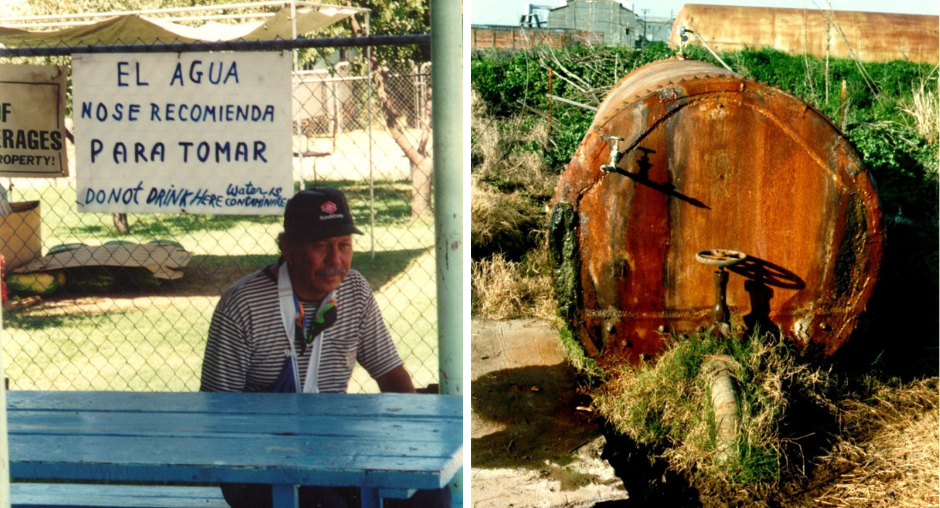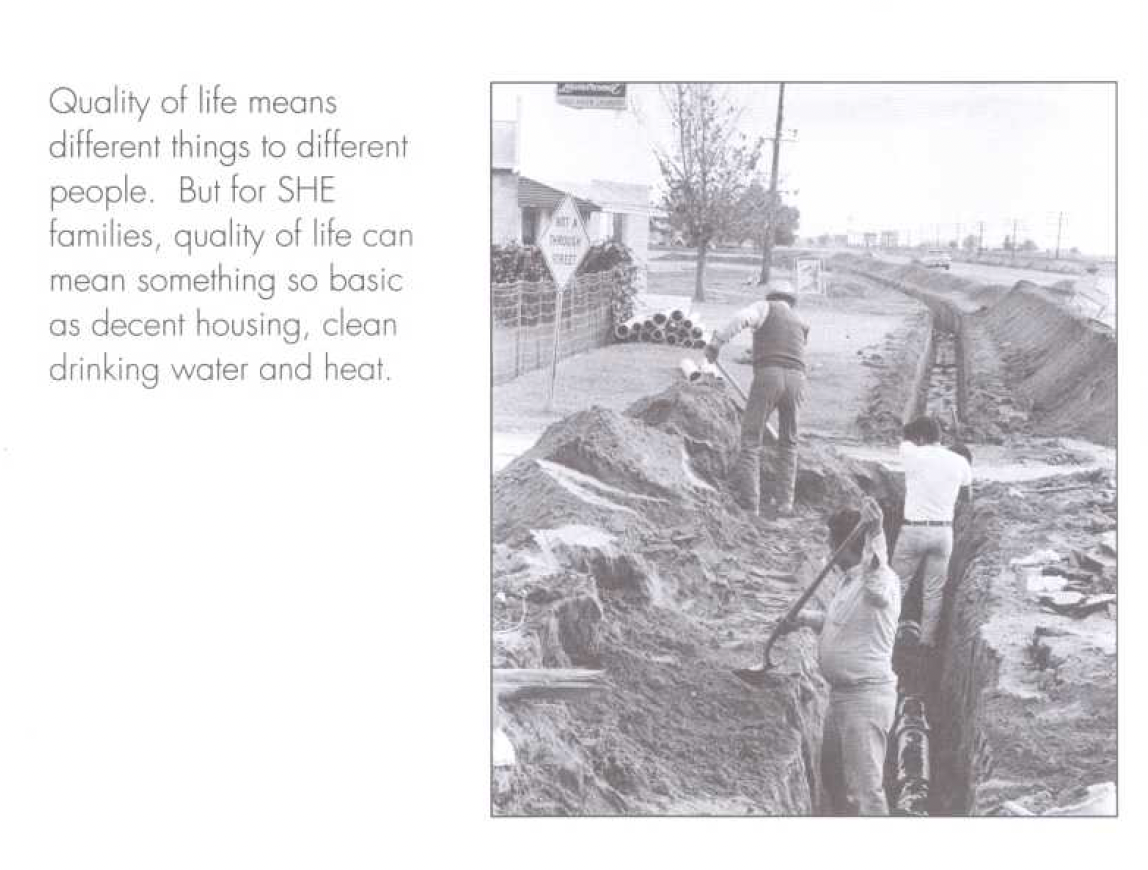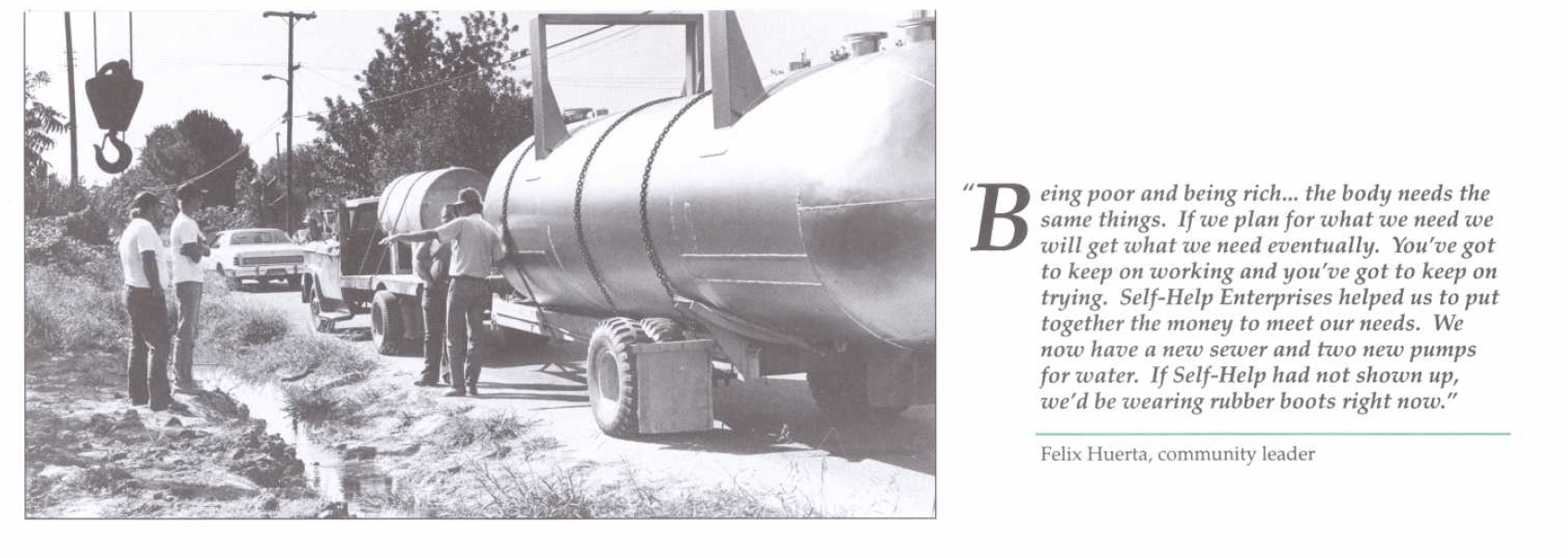SHE’s History of Community Development
SHE’s History of Community Development

Posted on April 1, 2024
To commemorate SHE’s 60th Anniversary, we are continuing our historical series highlighting the journey we’ve been on as an organization since 1965. While our roots were firmly planted in self-help housing for low-income farmworkers, the evolving needs of rural communities in the 1970s led us to expand our focus. In working with communities, it became apparent to SHE that many families lacked access to clean drinking water and adequate sewer. SHE began addressing rural community water and sewer needs in 1974, which allows for comprehensive approaches to address the basic and essential needs of rural communities.
In the early 1970s, although various SHE staff members were involved in “community development” activities outside of the organization, SHE had not formally become a provider of community development services until 1974. Early in 1975, the Board approved a contract with the National Demonstration Water Project. Although the initial contract was small, supporting one staff member, this was the beginning of SHE’s massive effort to improve the unsafe water and wastewater systems seemingly indigenous to the rural areas of the San Joaquin Valley. The initial six community projects with which SHE worked were quickly expanded to over 90 water and wastewater projects in 60 locations. This effort received a significant boost in 1976 when SHE received $250,000 from the Community Services Administration to be used for seed money by communities in the initial stages of improving their water and sewer systems.
 America’s water supply became recognized as the crisis of the 1980s, and in no location was the concern greater than in the San Joaquin Valley. Inadequate water systems and unsafe drinking and well water deeply affected rural residents and farm workers. Rapid population growth and intensive agricultural activities strained existing infrastructure, leading to insufficient water treatment and distribution networks. Many rural communities, particularly those inhabited by farm workers, faced disproportionate risks and exacerbated their vulnerability to water-related health hazards. The reliance on groundwater extraction, often without sustainable management practices, further depletes aquifers and contaminated wells with agricultural pollutants, posing significant health risks to those relying on them for drinking water. Decades of neglect and underinvestment in infrastructure perpetuated this cycle of water insecurity and underscored the need for SHE’s involvement to help safeguard the well-being of rural residents.
America’s water supply became recognized as the crisis of the 1980s, and in no location was the concern greater than in the San Joaquin Valley. Inadequate water systems and unsafe drinking and well water deeply affected rural residents and farm workers. Rapid population growth and intensive agricultural activities strained existing infrastructure, leading to insufficient water treatment and distribution networks. Many rural communities, particularly those inhabited by farm workers, faced disproportionate risks and exacerbated their vulnerability to water-related health hazards. The reliance on groundwater extraction, often without sustainable management practices, further depletes aquifers and contaminated wells with agricultural pollutants, posing significant health risks to those relying on them for drinking water. Decades of neglect and underinvestment in infrastructure perpetuated this cycle of water insecurity and underscored the need for SHE’s involvement to help safeguard the well-being of rural residents.
“Being without water is very stressful because every time the community’s pump was out, we didn’t know how long we were going to be without water. The tests for our new pipeline came back clear and our water is safe to drink. I can cook and have a glass of water.” ~ Lucy Hernandez, President of the West Goshen Mutual Water Company
Self-Help Enterprises emerged as pioneers in community development during this period, actively addressing the challenges faced by rural residents in accessing safe drinking water and sewer services in the Central Valley. Today, the vital services SHE initiated remain essential, reflecting ongoing needs for equitable access to safe water and sanitation infrastructure in rural areas across the valley. Stay tuned for next month’s newsletter to learn about SHE’s current Community Development services.
Recent Posts
Recent Comments
Archives
- October 2024
- September 2024
- August 2024
- July 2024
- June 2024
- April 2024
- February 2024
- January 2024
- December 2023
- October 2023
- September 2023
- August 2023
- July 2023
- June 2023
- May 2023
- April 2023
- March 2023
- February 2023
- December 2022
- October 2022
- September 2022
- August 2022
- July 2022
- May 2022
- December 2021
- October 2021
- September 2021
- August 2021
- July 2021
- June 2021
- May 2021
- April 2021
- March 2021
- January 2021
- December 2020
- November 2020
- October 2020
- September 2020
- July 2020
- June 2020
- May 2020
- April 2020
- March 2020
- February 2020
- January 2020
- December 2019
- November 2019
- October 2019
- September 2019
- August 2019
- July 2019
- June 2019
- May 2019
- April 2019
- March 2019
- February 2019
- January 2019
- December 2018
- November 2018
- October 2018
- September 2018
- August 2018
- July 2018
- June 2018
- May 2018
- April 2018
- March 2018
- February 2018
- January 2018
- December 2017
- November 2017
- October 2017
- September 2017
- August 2017
- July 2017
- June 2017
- May 2017
- April 2017
- March 2017
- February 2017
- January 2017
- December 2016
- November 2016
- October 2016
- September 2016
- August 2016
- July 2016
- June 2016
- May 2016
- April 2016
- March 2016
- February 2016
- December 2015
- November 2015
- October 2015
- September 2015
- August 2015
- July 2015
- June 2015
- May 2015
- April 2015
- February 2015
